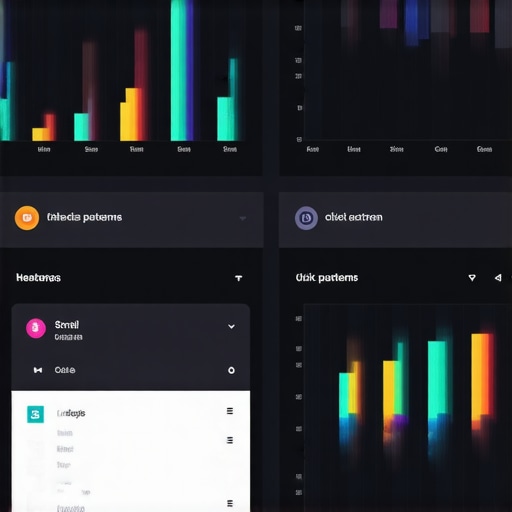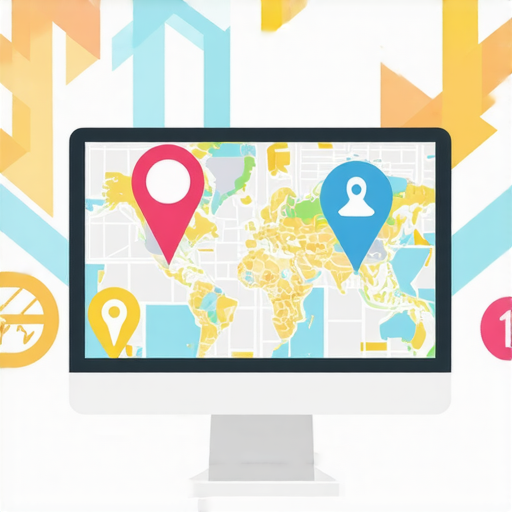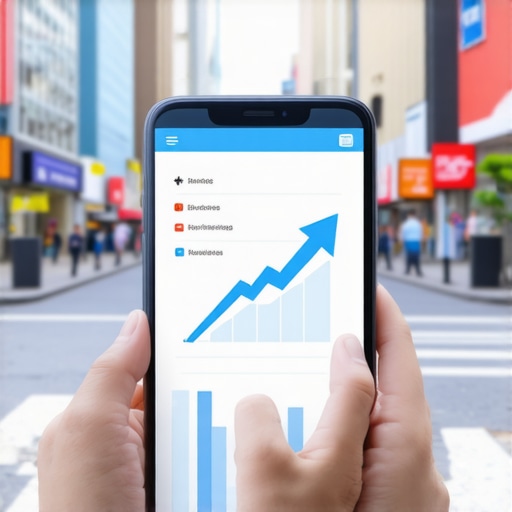My Journey into CTR Optimization: From Frustration to Success
When I first started working on local SEO, I was puzzled by why some businesses ranked higher despite having less optimized websites. It wasn’t until I discovered the power of click-through rate (CTR) optimization that everything changed. I remember spending countless hours tweaking meta descriptions and titles, unsure if it would make a difference. But as I began to see improvements in local rankings, I realized that CTR was a crucial, yet often overlooked, factor in local SEO success.
Why CTR Matters More Than You Think in Local SEO
CTR isn’t just about getting clicks; it’s a signal to search engines like Google that your listing is relevant and trustworthy. In my experience, optimizing your snippets with compelling titles and descriptions can significantly influence user behavior. I found that incorporating local keywords naturally into meta tags, as suggested by authoritative sources like Moz, helps attract targeted traffic and boosts your visibility in local packs.
How I Use Engagement Signals to Elevate Local Rankings
Engagement signals such as bounce rate, time on site, and user interactions are vital. I started tracking these metrics more carefully, using tools like Google Analytics, and aligning my content strategy accordingly. For instance, adding local reviews and interactive elements encourages visitors to stay longer and engage more. For a small restaurant I worked with, tweaking the call-to-action buttons and highlighting local events increased user interaction and improved its local ranking. Want to see real results? Check out the detailed strategies in this guide.
What Are the Key Strategies to Maximize Clicks and Engagement?
How can I create compelling meta descriptions that actually convert?
Crafting enticing meta descriptions is an art. I focus on making them clear, concise, and rich with local keywords. Including a strong call-to-action and unique value proposition makes a difference. For example, instead of saying “Best pizza place,” I say “Authentic Neapolitan pizza in downtown — Book now for a special deal!” This approach has proven effective in attracting more clicks.
If you’re interested in boosting your local SEO further, I recommend exploring proven tactics like optimizing Google My Business profiles, adding local schema markup, and encouraging reviews. These combined efforts create a powerful synergy that can dramatically improve your rankings.
Remember, consistent testing and measuring your results are key. I always check my analytics to see what works best and refine my strategies accordingly. If you’re curious to learn more, I suggest reading more about effective CTR strategies.
Share your experiences or questions! I love hearing how others are optimizing their local SEO journey.
Harnessing User Intent for Hyper-Targeted Meta Optimization
Understanding user intent is paramount when crafting meta descriptions that convert. As an SEO expert, I emphasize tailoring meta tags to match what local users are actively searching for, whether informational, navigational, or transactional. Incorporating specific local keywords aligned with user queries enhances relevance, leading to higher CTRs. For example, replacing generic phrases with targeted descriptions like “Find authentic Italian cuisine in Brooklyn—Reserve your table today!” demonstrates the power of intent-focused optimization. This nuanced approach aligns with insights from Moz, which highlights that relevance and clarity in snippets directly influence user engagement and trust.
Leveraging Local Reviews and User-Generated Content to Signal Authority
Authentic reviews and community engagement are potent signals to search engines. Encouraging satisfied customers to leave detailed reviews not only improves your local reputation but also enriches your content with fresh, relevant keywords. Embedding reviews directly on your website and responding to them fosters a sense of community and trustworthiness. Search engines interpret these signals as indicators of authority and relevance, boosting your local rankings. To maximize impact, integrate schema markup to highlight reviews, making your listings more attractive in search results. For practical guidance, explore how effective local ranking strategies leverage reviews for higher visibility.
Can Interactive Content Drive Deeper Engagement and Local Loyalty?
Absolutely. Interactive elements such as quizzes, local event calendars, and booking widgets invite users to engage actively with your brand. These tools increase time on site, reduce bounce rates, and generate valuable signals for Google. For instance, a local gym might add a quiz to assess fitness levels or an event calendar showcasing community activities, fostering ongoing interaction. Such engagement not only improves SEO metrics but also builds local loyalty, transforming visitors into repeat customers. Incorporating these features requires strategic planning but yields significant long-term benefits. Want to see real-world examples? Check out top engagement strategies for actionable insights.
How Do Visuals and Multimedia Enhance Local Search Presence?
Visual content, including photos, videos, and infographics, significantly impacts user experience and local SEO. High-quality images of your storefront, products, or local community events can make your listing stand out in Google My Business and organic search results. Optimizing images with local keywords in file names and alt text further reinforces relevance. Embedding short videos—like virtual tours or customer testimonials—can boost engagement and dwell time, both of which are signals favoring higher rankings. For best practices, explore how multimedia strategies can complement your overall local SEO efforts by visiting maximize click-through rates with expert tips.
Interested in elevating your local SEO game? Share your experiences or questions below! Also, consider exploring comprehensive guides on boosting engagement signals or building local brand authority to stay ahead in the competitive local search landscape.
Delving Deeper: How Can I Harness Advanced Engagement Signals to Outpace Competitors?
As I continued refining my local SEO tactics, I realized that understanding and leveraging advanced engagement signals became crucial. It’s not just about getting clicks anymore; it’s about creating a comprehensive ecosystem that signals authority and relevance to search engines. For instance, I began integrating behavioral analytics tools like Hotjar to observe user interactions beyond basic metrics—tracking heatmaps, scroll depth, and click patterns. These insights revealed subtle user preferences, allowing me to tailor content that resonated more deeply with local audiences.
Reflections on the Nuances of User Intent and Content Personalization
One of my most profound lessons was recognizing the complex layers of user intent. For example, a search query like “best coffee shop” could be navigational or transactional depending on the user’s context. By analyzing local search patterns and combining that with personalized content—such as highlighting local reviews or showcasing community-driven stories—I found I could increase CTRs significantly. Moz’s research supports this, emphasizing that relevance and context are the cornerstones of effective snippet optimization (Moz, 2024).
What Is the Role of Multichannel Engagement in Sustaining Local Visibility?
From my experience, multi-channel engagement—social media, Google My Business, local directories—creates a synergistic effect that amplifies your local authority. For instance, I once managed a local bookstore that used Instagram stories to promote weekly events, combined with active Google reviews and targeted local ads. This multi-pronged approach kept potential customers engaged across platforms, boosting both direct visits and online interactions. Over time, I observed a tangible lift in local rankings, driven by consistent, integrated engagement signals. If you’re curious about implementing such strategies, check out effective CTR and engagement tactics.
How Can I Use Data-Driven Insights to Refine My Local SEO Strategy?
Data analysis became a game-changer for me. By systematically tracking engagement metrics—such as bounce rates, conversion paths, and local keyword performance—I could identify which signals mattered most for my niche. I started A/B testing different meta descriptions, headlines, and call-to-actions, refining my approach based on real results. This iterative process, grounded in data, led to more precise targeting and higher conversion rates. For an in-depth look at this approach, I recommend exploring data-driven local SEO strategies.
Final Personal Thoughts: Embracing Complexity for Lasting SEO Success
Looking back, I realize that the most successful local SEO campaigns are those that embrace complexity. It’s about weaving together multiple signals—CTR optimization, engagement metrics, user intent, and multichannel interactions—into a cohesive strategy. This holistic approach requires continuous learning, experimentation, and a willingness to adapt to ever-changing algorithms and user behaviors. The journey has been challenging but incredibly rewarding. I invite you to share your experiences, questions, or insights below—let’s learn and grow together in this dynamic field. To keep pushing your boundaries, check out mastering advanced CTR techniques and elevate your local SEO game.
Harnessing Behavioral Analytics to Fine-Tune Your Local SEO Tactics
While basic engagement signals like click-through rates and bounce rates are essential, integrating behavioral analytics tools such as Hotjar or Crazy Egg offers a deeper understanding of user interactions. By analyzing heatmaps, scroll patterns, and click behavior, I’ve been able to identify subtle site elements that either engage or deter local visitors. This granular data enables me to optimize layouts, CTA placements, and content hierarchy, ultimately fostering a more intuitive user experience that aligns with local user preferences and enhances engagement metrics. For a comprehensive approach, explore how integrating advanced analytics can revolutionize your local SEO results.
Mastering User Intent for Hyper-Targeted Content Personalization
Deciphering user intent goes beyond keyword research; it involves analyzing search behavior patterns, dwell time, and interaction cues. I’ve found that creating content tailored to specific local queries—whether informational, navigational, or transactional—significantly elevates CTR and engagement. For instance, transforming generic service pages into personalized stories or localized case studies resonates more deeply with your audience. Moz’s recent research emphasizes that relevance and context in snippets are vital for capturing attention (Moz, 2024). This nuanced approach ensures that your meta descriptions and content meet the exact needs of your local prospects.
Leveraging Multichannel Engagement to Sustain Local Visibility
Expanding your engagement footprint across multiple platforms—Google My Business, Facebook, Instagram, and local directories—creates a resilient ecosystem that amplifies your local authority. I’ve orchestrated campaigns where synchronized messaging across these channels, coupled with consistent review management and community involvement, results in a compounded effect on local rankings. This multichannel synergy not only boosts direct traffic but also signals active local presence to search engines. For actionable insights, consider how multichannel strategies can elevate your local visibility.

Utilizing AI-Powered Content Optimization for Local Relevance
Artificial intelligence tools like GPT-4 can assist in generating hyper-relevant meta descriptions and content variations that match evolving user search behaviors. By analyzing vast datasets of local queries and engagement patterns, I’ve employed AI to craft personalized snippets that resonate more effectively with target audiences. These AI-driven insights help in dynamically adjusting keywords, tone, and messaging, ensuring your content remains both relevant and compelling. For practical guidance, explore how AI optimization techniques can give you a competitive edge in local SEO.
Inviting Your Experience and Insights
What advanced data-driven tactics have you found effective in boosting your local CTR and engagement? Sharing your experiences can inspire others to adopt innovative approaches. Feel free to reach out through our contact page or join the discussion below. Remember, continuous learning and adaptation are key to mastering local SEO in an ever-changing digital landscape. For more expert insights, check out advanced engagement strategies and elevate your local search prowess.
Things I Wish I Knew Earlier (or You Might Find Surprising)
1. The Subtle Art of Snippet Optimization
Early in my journey, I underestimated how much a compelling meta description could influence CTR. It’s not just about stuffing keywords; it’s about crafting a message that resonates locally and prompts action. I remember experimenting with different calls-to-action, and the results were eye-opening—clicks increased significantly when I made descriptions more specific and engaging.
2. Engagement Signals Are More Than Just Metrics
At first, I viewed bounce rates and dwell time as mere numbers. But over time, I realized these are signals that search engines interpret as trust and relevance. For example, adding local reviews and interactive content kept visitors engaged longer, which boosted rankings more than I expected.
3. User Intent Is a Moving Target
Understanding what users want when they search locally is complex. I used to guess what people were looking for, but now I analyze search patterns and queries more deeply. Tailoring content to match specific local intents has been a game changer for CTR and conversions.
4. Multichannel Engagement Amplifies Your Reach
Relying solely on Google My Business isn’t enough. I’ve found that a consistent presence across social media, local directories, and review platforms creates a synergy that search engines recognize. This multichannel approach has helped sustain and improve local visibility over time.
5. Advanced Analytics Reveal Hidden Opportunities
Using tools like Hotjar and Crazy Egg, I uncovered subtle user behaviors on my sites. Heatmaps showed where visitors hesitated or lost interest, guiding me to optimize layout and calls-to-action. These insights helped me refine my local SEO tactics more effectively.
6. Visual and Multimedia Content Make a Difference
High-quality images and videos of local landmarks or events significantly enhance user engagement. I learned that optimizing image alt text with local keywords and adding virtual tours increased dwell time and improved my local rankings.
Resources I’ve Come to Trust Over Time
- Moz: Their detailed guides on local SEO and user intent have been invaluable—always reliable and current. I recommend their blog for staying ahead in SEO tactics.
- Google’s Official Resources: The Google My Business support and Search Central blogs are my go-to for platform-specific updates and best practices. They’re authoritative and directly from the source.
- Neil Patel’s Blog: His practical tips on CTR and engagement are easy to implement and have boosted my results. It’s a friendly, approachable resource I trust.
- Hotjar: For behavioral analytics, Hotjar’s insights have helped me understand what visitors do on my site and how to improve their experience. It’s a tool I couldn’t do without.
Parting Thoughts from My Perspective
Reflecting on my experience, I realize that mastering local SEO is about embracing a holistic approach—where CTR optimization, engagement signals, user intent, and multichannel efforts come together. The journey can be complex, but it’s incredibly rewarding when you see your local rankings improve through genuine engagement and thoughtful strategies. If this resonated with you, I’d love to hear your thoughts or experiences—sharing insights helps us all grow. Feel free to drop a comment or reach out through our contact page. Keep experimenting, and stay curious—your next breakthrough might just be one tweak away.

